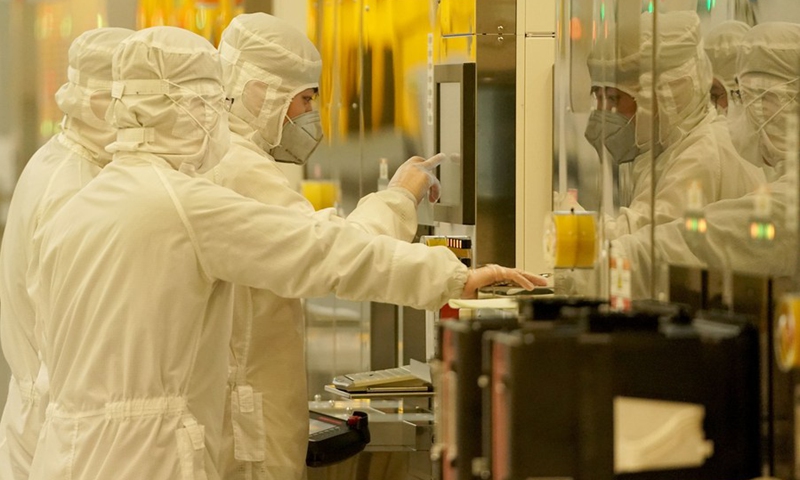China lifts technology innovation to new national height
By Li Xuanmin Source: Global Times Published: 2020/11/4 17:58:40

Technicians work in a workshop of Wuhan Xinxin Semiconductor Manufacturing Co., Ltd (XMC) in Wuhan Donghu New Technological Development Zone in Wuhan, capital of central China's Hubei Province, Feb. 14, 2020. (Photo: Xinhua)
With technology self-reliance and basic scientific research capacity elevated to a national strategic level in a freshly released blueprint for China's development, Beijing is set to break through the Washington-led technology blockade in the coming years and become a leading player in many high-tech sectors such as semiconductors, artificial intelligence (AI) and quantum computing, observers said.
The Communist Party of China (CPC) Central Committee on Tuesday released the full text of proposals for formulating the 14th Five-Year Plan (2021-25) for National Economic and Social Development and the Long-Range Objectives through the Year 2035. The document was adopted at the fifth plenary session of the 19th CPC Central Committee, which closed on October 29.
Unusually, the proposal dedicated a specific third chapter to highlighting technology innovation, immediately after mapping out key economic goals. According to the text, indigenous innovation will play a key role in China's industrial modernization, and the country will make technology self-reliance an underpinning strategy for national growth.
China will mobilize national resources to make breakthroughs in key technologies, while scaling up basic research and development (R&D), read the document.
For the first time, it pinpointed leading sectors in which Beijing will strive to launch strategically important projects. Those sectors include AI, semiconductors, quantum computing and health-related sciences, some of which have been a battle ground in the boiling technology war launched by the US against China.
Other accompanying measures, including bolstering the innovation ability of enterprises, improving the technology innovation mechanism and cultivating talent, are included in the proposal.
Industry observers said the tone-setting plan will raise China's technology development to an unprecedented position, against the backdrop of Washington's relentless crackdown on Chinese technology behemoths including Huawei, TikTok and Tencent.
"The plan is far-sighted and solid compared with previous proposals. The goal is clear: to ensure China's sustainable technology capacity and more importantly, to self-develop key technologies and innovations," Xiang Ligang, director-general of the Beijing-based Information Consumption Alliance, told the Global Times on Wednesday.
The plan also devotes extensive attention to basic R&D capacity, where China still lags behind some developed countries, Xiang added.
While strengthening chip manufacturing ability will be a priority in the next few years, Geng Bo, deputy secretary-general of the China Solid State Lighting Alliance — which participated in drafting the 14th Five-Year Plan — told the Global Times that China may have stepped up efforts to develop the third-generation semiconductor technology.
Third-generation semiconductor technology is considered a different roadmap from the prevailing second-generation technology, which uses silicon wafers as the prime material.
Geng said that it would be a "fresh start" for every player in the world, and China may gain an edge thanks to an early start.
Observers believed that the plan will help China to move up the technology ladder rapidly, and China may be able to achieve a self-sufficiency rate over 70 percent in key industrial sectors in the next five years.
"We will be a world-leading technology innovator and player by 2035, which could give China more bargaining chips in the global tech race," Xiang stressed.